| Article ID | Journal | Published Year | Pages | File Type |
|---|---|---|---|---|
| 73018 | Microporous and Mesoporous Materials | 2014 | 9 Pages |
•Submicronic mesoporous silica spheres were derivatized with silver nanoparticles.•Formation of particle clusters comprising interparticle voids revealed by 129Xe NMR.•Ag-functionalized materials retained much gaseous iodine in an irreversible manner.•The AgI surface phase was thermally stable up to 800 K in air.•The systems recommended for iodine entrapment and immobilization from gas phase.
Submicron-in-size silica particles with controllable morphology, particle size and mesoporosity, have been prepared under basic conditions making use of cationic alkyltrimethylammonium surfactants (CnTAB, n = 12,16,18) as porogens. Gaseous nitrogen adsorption, XRD and TEM experiments revealed quasi-spherical homodispersed objects possessing regular mesopores of the MCM-41 type; lengthening of the hydrophobic tail of the template resulted in smaller particles with greater intraparticle pores. The aggregation and sintering of individual silica particles during the calcination step led to the formation of particle clusters comprising interparticle voids, as evidenced by the 129Xe NMR and TEM studies. The calcined particles were subsequently loaded with metallic silver. The measurements of iodine adsorption onto Ag-functionalized materials from the gas phase were supplemented by XRD, SEM/EDX, and TGA/DTA studies. It was demonstrated that the functionalized silica retained much gaseous iodine in an irreversible manner, mainly as an ‘interfacial’ AgI. The best compromise between the textural parameters and the post-synthesis functionalization was obtained for the large-pore silica templated with C18TAB. Indications about the presence of silver metal nanoparticles, displaying certain heterogeneity in size and shape, within the pores of this sample were given based on the analysis of 129Xe NMR spectra supplemented by UV–Visible absorption spectra and powder XRD patterns in the wide-angle region. The material can be recommended for the entrapment and immobilization of radioactive iodine in the nuclear industry since it guarantees that the adsorbed pollutant is primarily localized within the material pores and is thermally stable up to 800 K in air.
Graphical abstractFigure optionsDownload full-size imageDownload as PowerPoint slide
